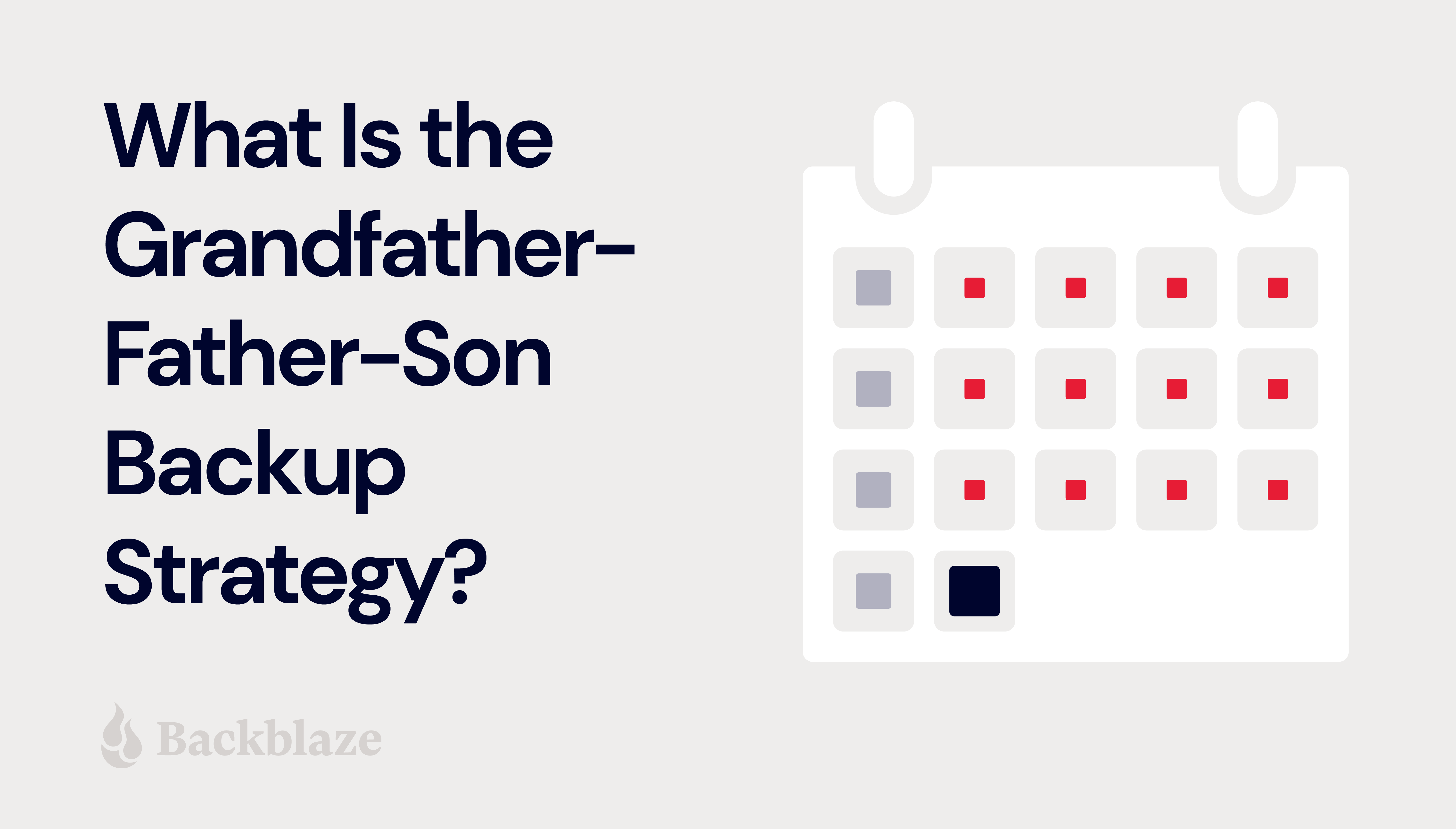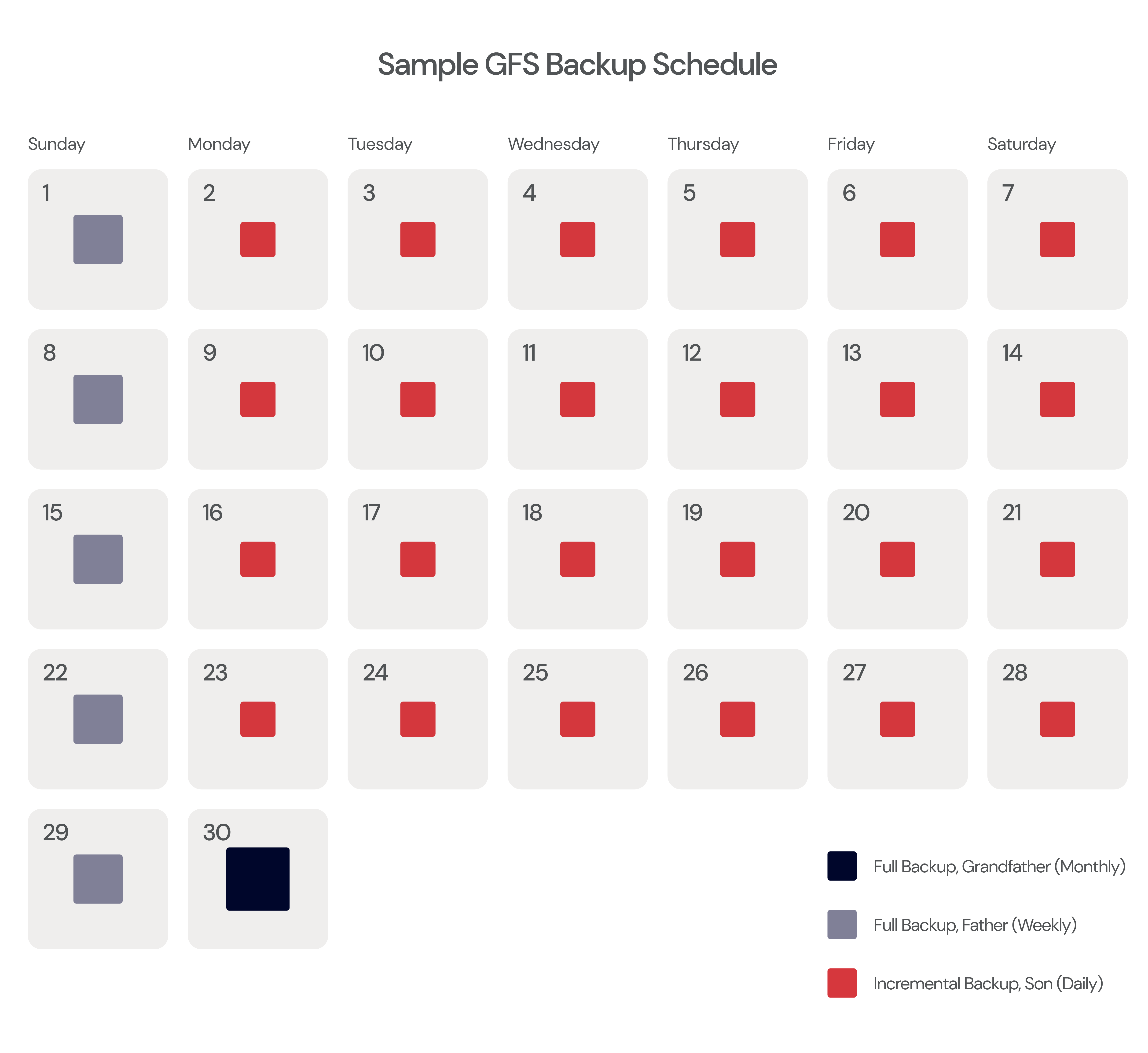Post Syndicated from Kari Rivas original https://www.backblaze.com/blog/better-backup-practices-what-is-the-grandfather-father-son-approach/

They say the older you get, the more you become your parents. It’s so true, Progressive Insurance built an entire marketing campaign around it. (Forcing food on your family? Guilty.) But when it comes to backups, generational copies are a good thing. In fact, there’s a widely-used backup approach based on the idea—grandfather-father-son (GFS) backups.
In this post, we’ll explain what GFS is and how GFS works, we’ll share an example GFS backup plan, and we’ll show you how you can use GFS to organize your backup approach.
What Are Grandfather-Father-Son Backups?
Whether you’re setting up your first cloud backup or researching how to enhance your data security practices, chances are you’ve already got the basics figured out, like using at least a 3-2-1 backup strategy, if not a 3-2-1-1-0 or a 4-3-2. You’ve realized you need at least three total copies of your data, two of which are local but on different media, and one copy stored off-site. The next part of your strategy is to consider how often to perform full backups, with the assumption that you’ll fill the gap between full backups with incremental (or differential) backups.
One way to simplify your decision-making around backup strategy, including when to perform full vs. incremental backups, is to follow the GFS backup scheme. GFS provides recommended, but flexible, rotation cycles for full and incremental backups and has the added benefit of providing layers of data protection in a manageable framework.
Refresher: Full vs. Incremental vs. Differential vs. Synthetic Backups
There are four different types of backups: full, incremental, synthetic full, and differential. And choosing the right mix of types helps you maximize efficiency versus simply performing full backups all the time and monopolizing bandwidth and storage space. Here’s a quick refresher on each type:
- Full backups: A complete copy of your data.
- Incremental backups: A copy of data that has changed or has been added since your last full backup or since the last incremental backup.
- Synthetic full backups: A synthesized “full” backup copy created from the full backup you have stored in the cloud plus your subsequent incremental backups. Synthetic full backups are much faster than full backups.
- Differential backups: A specialized type of backups popular for database applications like Microsoft SQL but not used frequently otherwise. Differential backups copy all changes since the last full backup every time (versus incrementals which only contain changes or additions since the last incremental). As you make changes to your data set, your differential backup grows.
Check out our complete guide on the difference between full, incremental, synthetic full, and differential backups here.
How Do GFS Backups Work?
In the traditional GFS approach, a full backup is completed on the same day of each month (for example, the last day of each month or the fourth Friday of each month—however you want to define it). This is the “grandfather” cycle. It’s best practice to store this backup off-site or in the cloud. This also helps satisfy the off-site requirement of a 3-2-1 strategy.
Next, another full backup is set to run on a more frequent basis, like weekly. Again, you can define when exactly this full backup should take place, keeping in mind your business’s bandwidth requirements. (Because full backups will most definitely tie up your network for a while!) This is the “father” cycle, and, ideally, your backup should be stored locally and/or in hot cloud storage, like Backblaze B2 Cloud Storage, where it can be quickly and easily accessed if needed.
Last, plan to cover your bases with daily incremental backups. These are the “son” backups, and they should be stored in the same location as your “father” backups.
GFS Backups: An Example
In the example month shown below, the grandfather backup is completed on the last day of each month. Father full backups run every Sunday, and incremental son backups run Monday through Saturday.

It’s important to note that the daily-weekly-monthly cadence is a common approach, but you could perform your incremental son backups even more often than daily (Like hourly!) or you could set your grandfather backups to run yearly instead of monthly. Some choose to run grandfather backups monthly and “great-grandfather” backups yearly. Essentially, you just want to create three regular backup cycles (one full backup to off-site storage; one full backup to local or hot storage; and incremental backups to fill the gaps) with your grandfather full backup cycle being performed less often than your father full backup cycle.
How Long Should You Retain GFS Backups?
Last, it’s important to also consider your retention policy for each backup cycle. In other words, how long do you want to keep your monthly grandfather backups, in case you need to restore data from one? How long do you want to keep your father and son backups? Are you in an industry that has strict data retention requirements?
You’ll want to think about how to balance regulatory requirements with storage costs. By the way, you might find us a little biased towards Backblaze B2 Cloud Storage because, at $5/TB/month, you can afford to keep your backups in quickly accessible hot storage and keep them archived for as long as you need without worrying about an excessive cloud storage bill.
Ultimately, you’ll find that grandfather-father-son is an organized approach to creating and retaining full and incremental backups. It takes some planning to set up but is fairly straightforward to follow once you have a system in place. You have multiple fallback options in case your business is impacted by ransomware or a natural disaster, and you still have the flexibility to set backup cycles that meet your business needs and storage requirements.
Ready to Get Started With GFS Backups and Backblaze B2?
Check out our Business Backup solutions and safeguard your GFS backups in the industry’s leading independent storage cloud.
The post Better Backup Practices: What Is the Grandfather-Father-Son Approach? appeared first on Backblaze Blog | Cloud Storage & Cloud Backup.